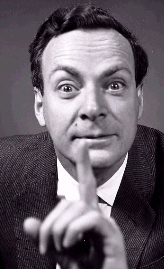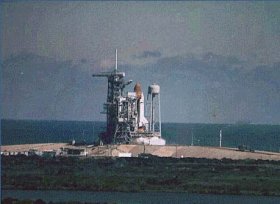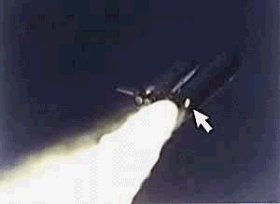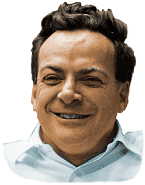Richard Feynman

http://www.physics.gla.ac.uk/introPhy/Famous/feynman/feynman.html

http://www.physics.gla.ac.uk/introPhy/Famous/feynman/feynman.html
Richard Feynman was born on May 11, 1918 in Brooklyn to Lucille and Melville
Feynman. Feynman's childhood home was in the community of Far Rockaway,
in the outskirts if Manhattan.

When Feynman was born, his father, Melville, had already determined that Feynman would grow up to be a scientist. Melville had always dreamed to be a scientist. Unfortunately, Melville's dream was left unsatisfied only to live it through his son. Melville encouraged Feynman not to focus on things he knew, but rather things he did not know. This was the base of Richard Feynman's understanding. Feynman believed sincerely that what was important was not knowing the answers to questions, but instead asking the right questions. He believed that the answers wait patiently to be discovered.
Richard Feynman's mother, Lucille, also influenced his future success as a scientist. Lucille taught Feynman to take life lightly and to have a powerful sense of humor. While Melville allowed Feynman the tools to explore his future, Lucille taught him to laugh, take life lightly, and have courage in himself. Both of Feynman's parents played an important role in guiding their son to success.
When Feynman grew to be a young man in school, he fell in love with Arline Greenbaum, the girl of his dreams. It didn't take much for Arline to become the most important person in Feynman's life. Arline seemed to share his take on life. It is said that the pair were made for each other.
Later in his life, Feynman attended
college as a physics major. He finished his first four years in 1939 at
MIT, and then moved on to Princeton for graduate school. While at Princeton,
Feynman proposed to Arline. The two planned to be married after hecompleted
his PH.D. However, Arline started to become ill during this time. After
some time, she was diagnosed with
tuberculosis, and was not expected
to live much longer. Feynman took Arline's illness hard. He decided quickly
after Arline
was diagnosed that he would marry
her as soon as possible. He wanted to be responsible for her and take care
of her as
long as he could. Even though his
family advised against them marrying because of his unfinished schooling,
the two were married.
In 1942, Feynman still at Princeton took Arline and moved to Los Alamos, NM, to work on the highly secret project to build anb atomic bomb. At this time, the United States had just entered World War II, and it was feared that Germany was far along in engineering the nuclear bomb. As a result, the United States began a project called the Manhattan Project with the purpose of engineering a nuclear bomb before the axis powers did so. The best mathematicians, chemists, and physicists were asked to become a part of the project, which included Richard Feynman. At first Feynman didn't want to join the project. Building a bomb wasn't something he was interested in doing, but the idea that Germany might develop the bomb first scared him. So, Feynman and Arline moved to New Mexico. While Richard stayed in Los Alamos, Arline stayed in a hospital in Albuquerque. During the week, Richard would work on the bomb, and on the weekends, he would visit his wife, Arline. In July of 1945 Arline passed away with tuberculosis. Feynman kept Arline's death out of his mind by digging himself in his work. It wasn't long after when the nuclear bomb was complete.
After leaving Los Alamos, Feynman accepted a job at Cornell University. However, he was not happy there. He seemed to have lost his spunk, humor, carefree nature, and brilliance. He began to feel that the best times of his life were behind him. Feynman's slump took a turn when he received an invitation from Princeton. Feynman realized that his best times weren't behind him. In 1950, Feynman left Cornell to go to California Institute of Technology (Caltech) to study the problem of superfluidity in liquid helium where he would stay until his death.
In 1952, Feynman married Mary Louise Bell. She was an instructor in the history of decorative art. The marriage didn't last long when they divorced in 1956. Then in 1960, Feynman married his last wife, Gweneth Howarth. The two gave birth to a son, Carl, and adopted a daughter, Michelle.
In 1961, Feynman was asked to teach a two-year freshman course of introductory physics at Caltech. At first Feynman was hesitant about taking the position knowing that it would mean less devotion to his research. However, he felt excited to teach to the younger students who were curious about physics just as he had once been. So, he agreed to teach the class and had no regrets. From the material taught by Feynman, a series of three books were published called The Feynman Lectures on Physics. These books were later used in other scientific literature, and proved to be very important. However, not only did Feynman's material teach others, but they also taught himself. Through his lectures, he realized his fascination with art. He decided to take an introductory class in art, and after much time became a skilled artist.
Click here to see Feynman teach
In 1965, Feynman received the Nobel Prize for his work in quantum electrodynamics, also called QED, which had to do with the probability of a quantum from one state to another. The Nobel Prize didn't stop Feynman in his studies of physics. Shortly after, he began working on a breakthrough in superfluidity of helium. Unfortunately he was also working against three other scientists, John Bardeen, Leon Cooper, and Robert Schreiffer who solved the problem first. Another breakthrough Feynman worked on after receiving the Nobel Prize was called "weak decay". This study looked into the decay of a free neutron into an electron, proton, and anti-neutrino. Along with another theorist, Murray Gell-Mann, Feynman published a research paper presenting a new theory of "weak decay". It is said that this theory changed scientists understanding of nature.
In early 1979, Feynman was diagnosed with a rare form of cancer growing in his abdomen. Surgery removed the cancer, however, damaged his internal organs, which left Feynman weak. He was never one to worry, thought, and appreciated every moment he had left to live.
In the 1980s,
Feynman became very popular with the published best sellers, "Surely You're
Joking, Mr. Feynman!", and
"What Do You Care What Other
People Think?" both published by Ralph Leighton. These books helped distinguish
what a widely diverse man Richard Feynman really was. He was not only Richard
Feynman "The Nobelist Physicist", but also Richard Feynman the teacher,
storyteller, artist, juggler, and bongo player. Therefore, it was no surprise
that when the Challenger accident occurred in January 28, 1986,
NASA asked Feynman to help investigate. Feynman figured out what
was wrong with the Challenger, and announced in during a nationally televised
hearing. Feynman learned that the rubber used to seal the rocket booster
joints didn't expand when the temperature was below 32 degrees. The
temperature when the Challenger lifted off was 32 degrees F. Feynman also
discovered that the chance of failure of the shuttle was not 1 in 100,000
as the NASA officials stated, but rather a chance of 1 in 100. As Feynman
stated, because the O-rings could expand at 32 degrees, the gas found gaps
in the joints to escape. The leak turned into flames, which heated up the
gas tank and caused it to explode. The leak can be seen in the picture
below to the right next to the arrow.


In 1987, doctors discovered another tumor in Feynman. He was treated immediately
with surgery, but was still left very weak. A few days later, further
complications were found with Feynman's kidneys. Another surgery was suggested,
however, Feynman refused; he felt that enough was enough. On February
15, 1988 Feynman died. Feynman's obituary can been seen below. It
tells of his successes and shows how he was loved.

http://www.scs-intl.com/online/
RICHARD FEYNMAN, NOBEL LAUREATE IN PHYSICS; PROBED SHUTTLE DISASTER
Richard P. Feynman, a Nobel laureate in
physics, best-selling author and former member of the presidential commission
that investigated the Challenger disaster,
died Monday night in Los Angeles. He was 69. Mr. Feynman, who died at the
University of California at Los Angeles Medical
Center after an eight-year battle with abdominal cancer, was a popular
and energetic lecturer who, despite his illness,
continued to teach at the California Institute of Technology until two
weeks ago. Mr. Feynman graduated from the
Massachusetts Institute of Technology in 1939 and received his doctorate
from Princeton University in 1942. He was a
member of the team that developed the first atomic bomb at the Los Alamos
Scientific Laboratory. He was widely known for
his insatiable curiosity, gentle wit, brilliant mind and playful temperament.
These qualities were clearly evident in his popular
1985 book of reminiscences, "Surely You're Joking, Mr. Feynman," which
was on the New York Times best-seller list for 14
weeks. MIT physicist Philip Morrison called Mr. Feynman "the most original
theoretical physicist of our time," according to a
report by United Press International. Morrison said Mr. Feynman, who called
his Nobel Prize "a pain in the neck," was
"extraordinarily honest with himself and everyone else," and added that
"he didn't like ceremony or pomposity . . . he was
extremely informal. He liked colorful language and jokes." Mr. Feynman
attracted widespread attention during the Rogers
Commission hearings on the Challenger space shuttle accident in 1986. Frustrated
by witnesses' vague answers and by
slow bureaucratic procedures, he conducted an impromptu experiment that
proved a key point in the investigation: He
dunked a piece of the rocket booster's O-ring material into a cup of ice
water and quickly showed that it lost all resiliency at
low temperatures. In the commission's final report, Mr. Feynman accused
the National Aeronautics and Space
Administration of "playing Russian roulette" with astronauts' lives. His
driving curiosity was apparent when, in his last media
interview, he told The Boston Globe last year that his work on the shuttle
commission had so aroused his interest in the
complexities of managing a large organization like NASA that if he were
starting his life over, he might be tempted to study
management rather than physics. Ever playful and unintimidated by authority,
Mr. Feynman caused consternation in his years
with the Manhattan Project, which developed the atomic bomb, by figuring
out in his spare time how to pick the locks on filing
cabinets that contained classified information. Without removing anything,
he left taunting notes to let officials know that their
security system had been breached. Former Caltech president Marvin Goldberger,
now director of the Institute for Advanced
Study in Princeton, N.J., said Mr. Feynman was "a towering figure in 20th
century physics, always curious, always modest,
always ebullient, always willing to share his deep insights with students
and colleagues." He was awarded the Nobel Prize in
1965, along with Shinichero Tomonaga of Japan and Julian Schwinger of Harvard
University. The three had worked
independently on problems in the theory of quantum electrodynamics, which
describes how atoms produce radiation. He
reconstructed almost the whole of quantum mechanics and electrodynamics
in his own way, deriving a way to analyze atomic
interactions through simple diagrams, a method that is still used widely.
He described the theory for a general audience in
his 1986 book, "QED: The Strange Theory of Light and Matter." An earlier
textbook, "The Feynman Lectures on Physics,"
was published in 1963 and remains a leading text in physics classes. In
"Lectures," Mr. Feynman responded to charges that
scientific understanding detracts from an esthetic appreciation of nature:
"The vastness of the heavens stretches my
imagination -- stuck on this carousel my little eye can catch one-million-year-old
light. A vast pattern -- of which I was a part --
perhaps my stuff was belched from some forgotten star, as one is belching
there . . . It does not do harm to the mystery to
know a little about it. Far more marvelous is the truth than any artists
of the past imagined!" Mr. Feynman leaves his wife,
Gweneth; a son, Carl; a daughter, Michelle, and a sister, Joan Feynman.
A memorial service will be held at a later date.
CHANDL;02/16 LDRISC;02/17,17:05 FEYNMA17

http://www.scs-intl.com/online/